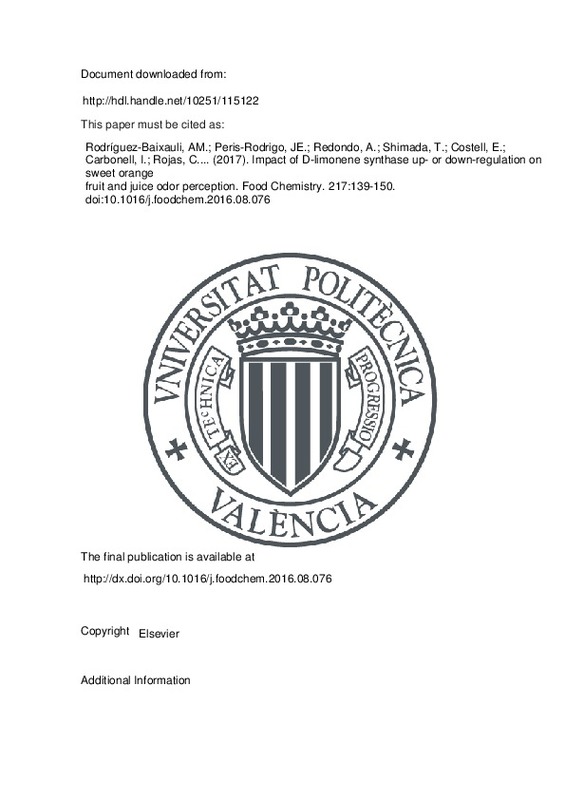JavaScript is disabled for your browser. Some features of this site may not work without it.
Buscar en RiuNet
Listar
Mi cuenta
Estadísticas
Ayuda RiuNet
Admin. UPV
Impact of D-limonene synthase up- or down-regulation on sweet orange fruit and juice odor perception
Mostrar el registro sencillo del ítem
Ficheros en el ítem
| dc.contributor.author | Rodríguez-Baixauli, Ana María
|
es_ES |
| dc.contributor.author | Peris-Rodrigo, Josep Enric
|
es_ES |
| dc.contributor.author | Redondo, Ana
|
es_ES |
| dc.contributor.author | Shimada, Takehiko
|
es_ES |
| dc.contributor.author | Costell, Elvira
|
es_ES |
| dc.contributor.author | Carbonell, Inmaculada
|
es_ES |
| dc.contributor.author | Rojas, Cristina
|
es_ES |
| dc.contributor.author | Peña, Leandro
|
es_ES |
| dc.date.accessioned | 2019-01-09T21:00:15Z | |
| dc.date.available | 2019-01-09T21:00:15Z | |
| dc.date.issued | 2017 | es_ES |
| dc.identifier.issn | 0308-8146 | es_ES |
| dc.identifier.uri | http://hdl.handle.net/10251/115122 | |
| dc.description.abstract | [EN] Citrus fruits are characterized by a complex mixture of volatiles making up their characteristic aromas, being the D-limonene the most abundant one. However, its role on citrus fruit and juice odor is controversial. Transgenic oranges engineered for alterations in the presence or concentration of few related chemical groups enable asking precise questions about their contribution to overall odor, either positive or negative, as perceived by the human nose. Here, either down- or up-regulation of a D-limonene synthase allowed us to infer that a decrease of as much as 51 times in D-limonene and an increase of as much as 3.2 times in linalool in juice were neutral for odor perception while an increase of only 3 times in ethyl esters stimulated the preference of 66% of the judges. The ability to address these questions presents exciting opportunities to understand the basic principles of selection of food. (C) 2016 Elsevier Ltd. All rights reserved. | es_ES |
| dc.description.sponsorship | We are grateful to Drs. Lorenzo Zacarias and M. Jesus Rodrigo (IATA-CSIC) for the GC-MS facilities and support. We would like to acknowledge also to Drs. Berta Alquezar and Elsa Pons for their critical review of the manuscript and to all the panelists that participated in the sensory panel. This research is being funded in part by Fundo de Defesa da Citricultura (Fundecitrus). | |
| dc.language | Inglés | es_ES |
| dc.publisher | Elsevier | es_ES |
| dc.relation.ispartof | Food Chemistry | es_ES |
| dc.rights | Reserva de todos los derechos | es_ES |
| dc.subject | D-Limonene | es_ES |
| dc.subject | Genetically-modified fruits | es_ES |
| dc.subject | Sensory panel | es_ES |
| dc.subject | Alcohols | es_ES |
| dc.subject | Ethyl esters | es_ES |
| dc.subject | Orange odor perception | es_ES |
| dc.subject | OAV | es_ES |
| dc.subject | Citrus sinensis | es_ES |
| dc.title | Impact of D-limonene synthase up- or down-regulation on sweet orange fruit and juice odor perception | es_ES |
| dc.type | Artículo | es_ES |
| dc.identifier.doi | 10.1016/j.foodchem.2016.08.076 | es_ES |
| dc.rights.accessRights | Abierto | es_ES |
| dc.contributor.affiliation | Universitat Politècnica de València. Instituto Universitario Mixto de Biología Molecular y Celular de Plantas - Institut Universitari Mixt de Biologia Molecular i Cel·lular de Plantes | es_ES |
| dc.description.bibliographicCitation | Rodríguez-Baixauli, AM.; Peris-Rodrigo, JE.; Redondo, A.; Shimada, T.; Costell, E.; Carbonell, I.; Rojas, C.... (2017). Impact of D-limonene synthase up- or down-regulation on sweet orange fruit and juice odor perception. Food Chemistry. 217:139-150. doi:10.1016/j.foodchem.2016.08.076 | es_ES |
| dc.description.accrualMethod | S | es_ES |
| dc.relation.publisherversion | http://dx.doi.org/10.1016/j.foodchem.2016.08.076 | es_ES |
| dc.description.upvformatpinicio | 139 | es_ES |
| dc.description.upvformatpfin | 150 | es_ES |
| dc.type.version | info:eu-repo/semantics/publishedVersion | es_ES |
| dc.description.volume | 217 | es_ES |
| dc.identifier.pmid | 27664619 | |
| dc.relation.pasarela | S\354493 | es_ES |
| dc.contributor.funder | Fundo de Defesa da Citricultura |







![[Cerrado]](/themes/UPV/images/candado.png)

